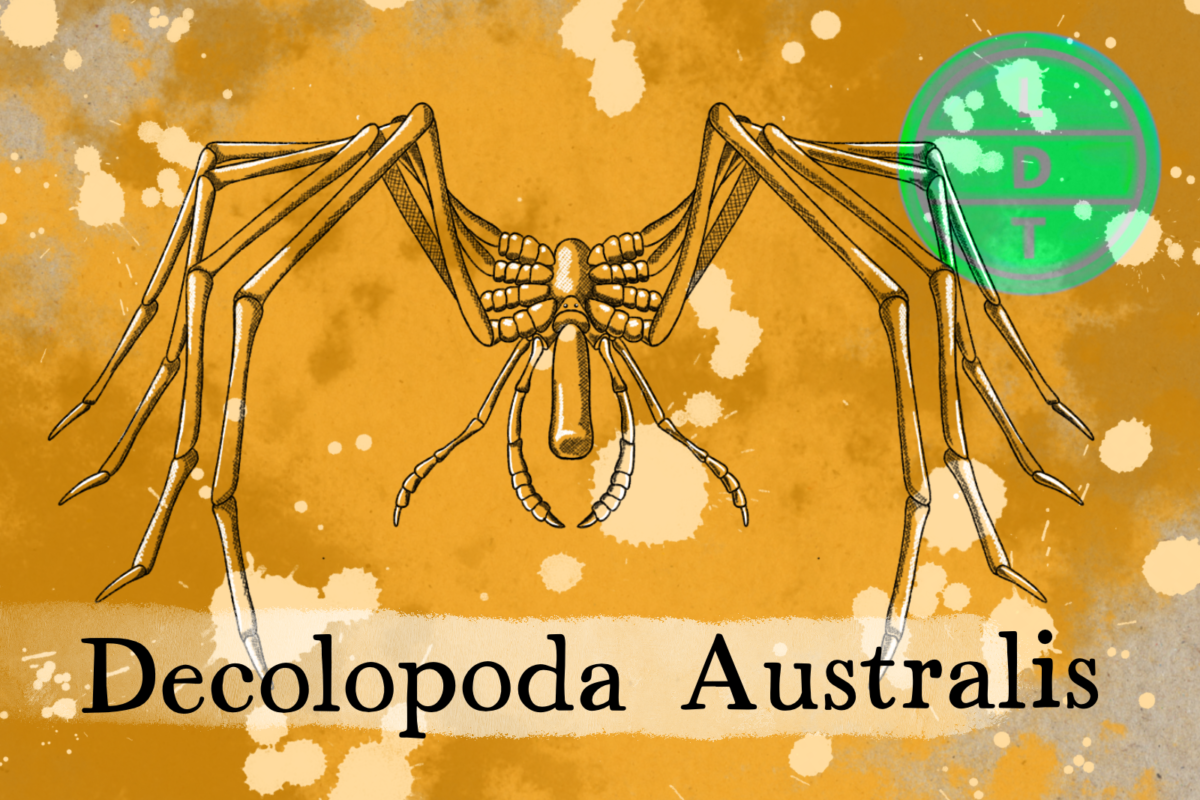“…and today we’re talking about a spider in the last place you’d think to look for one. But more on that later.”
In the coldest regions of the Arctic ocean, the depths harbor strange and alien life. Normally, living things take breathing for granted. Lungs, gills, trachea, it’s all about moving that sweet sweet oxygen throughout the body. The Giant Sea Spider, though, laughs at convention. When the water around you is rich with oxygen, you just need the right skin when you need to breathe here in Life, Death, and Taxonomy.
Description of the Sea Spider
Sea spiders have a small body size compared to their long, spindly legs. They kind of look like a cross between a spider and a crab. Their legs are their most striking feature, with most species having eight of them arranged in four pairs, although some species have up to five or six pairs. Legs can be ten times the length of their body.
Measure Up
Welcome to the beloved Measure Up segment. The official listener’s favorite part of the show! The part of the show when we present the animal’s size and dimension in relatable terms through a quiz that’s fun for the whole family. It’s also the part of the show that’s introduced by you when you send in audio of yourself saying, singing, or chittering the words Measure Up into ldtaxonomy at gmail dot com. We don’t have a new Measure Up intro.
Lucas the Spider
Length
- 11.8 inches (30 centimeters)
- How many sea spiders go into the world’s longest glacier?
- Hint: The Lambert glacier in Antarctica is the world’s largest glacier. It’s 60 miles (96 km) wide and 8,200 feet (2,500 meters) deep.
- 1,449,762 sea spiders. The glacier is 270 miles (435 km) long.
Depth
- 6,200 feet (1,890 m)
- How many sea spider living depths go into the average depth of the Indian Ocean?
- Hint: The Indian Ocean’s lowest point is the Java Trench at 24,442 feet (7,450 meters).
- 1.9 depths. The average depth of the Indian Ocean is 3,741 meters (12,274 feet).
Fast Facts
Our Antarctic sea spider lives in the Indian Ocean and, presumably, antarctica. In general, sea spiders can be found in a variety of locations, ranging from Australia and New Zealand, to the Pacific coast of the United States, to the Mediterranean Sea and the Caribbean Sea, and even to the north and south poles.
It’s one of the three species in its genus with ten legs.
During reproduction, males fertilize eggs externally. When the eggs are laid, the fathers care for them.
Some sea spider larvae are dependent on hosts for survival, including clams and marine worms. When they reach adulthood, they no longer need hosts.
Their digestive system is unique. They have diverticula, which are external digestive organs, extending into their legs. They also have a proboscis that allows them to suck nutrients from soft-bodied invertebrates.
Some members of the sea spider class are so small that each muscle is only a single cell.
Major Fact: No Needtobreathe
All animals need to breathe. Getting oxygen from the environment around them and transferring it to the vital organs is how almost everything bigger than the spiders living on your face gets by in life. And absolutely everything alive needs to exchange gas in some way.
Animals either have:
- Lungs – air bags that suck oxygen from the atmosphere and transfer it to the bloodstream to be carried to the organs and muscles. Mammals, birds, reptiles, and amphibians all have lungs
- Gills – Specialized organs covered with capillaries that absorb oxygen from water rather than from the air.
- Tracheae – Tubes that insects and similar animals have that allow air to pass directly to the tissues.
The sea spider has none of these things.
Since its body is so small, like a Scotsman drinking an aquarium of whiskey, they have hollow legs. Their guts, gonads, and gumption can all be found in their legs rather than their bodies. And the same goes for their respiratory system. But they don’t have normal lungs, gills, or tracheae. Plus, their heart is too weak to pump enough oxygen around the body to sustain itself.
This is why there aren’t any land arthropods this size. The amount of oxygen density required just can’t sustain a large arthropod since its tracheae would be too long and the oxygen would be diffused before it reached the insect’s tissue. A large arthropod could only live in a very oxygen-rich environment, you know, like Antarctic waters. Which is fine if you’re a crab and have gills, but the sea spider doesn’t have room for gills. But since tracheae only work with air and not water, researchers spent years not really knowing how sea spiders breathed.
However, recently, they finally discovered that it was through these tiny pores in the hard carapace surrounding their legs. The water goes into the pores, the oxygen is absorbed into the gut tissue, and the legs contract to push the oxygen around the body.
So while almost everything else either pumps oxygen around using a circulatory system powered by some sort of heart or gets oxygen directly injected into its tissues, the sea spider uses its stomach and intestines-which are in its legs, mind you-to breathe.
Ending: So for you out there in Podcastia, if you’re feeling stressed, relax, close your eyes, and just take a nice deep breath with your intestines like the giant sea spider here in LDT.

